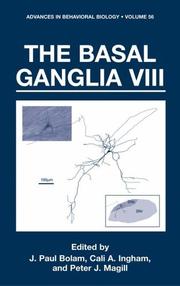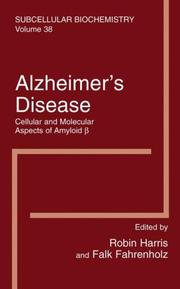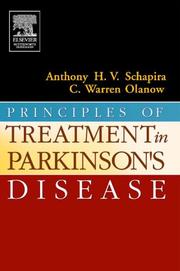| Listing 1 - 7 of 7 |
Sort by
|

ISBN: 0387280650 9786610612222 1280612223 0387280669 1489993398 Year: 2005 Publisher: New York ; London : Springer,
Abstract | Keywords | Export | Availability | Bookmark
 Loading...
Loading...Choose an application
- Reference Manager
- EndNote
- RefWorks (Direct export to RefWorks)
The aim of the International Meetings of the Basal Ganglia Society (IBAGS) is to provide a unique environment for the open presentation and discussion of new and challenging information about the basal ganglia as it relates to health and disease, covering all areas of basic science and research. Specific topics of the proceedings of this Eighth International Triennial Meeting of the Basal Ganglia Society include behavior, circuitry, functional imaging, modelling, movement disorders, neuropathology, neurotransmitters, pharmacology, physiology, plasticity, treatments for basal ganglia disorders, ventral systems, health and disease, immunology and basal ganglia, and much more.
Basal ganglia. --- Basal ganglia --- Brain Diseases --- Publication Formats --- Biological Science Disciplines --- Cerebrum --- Medicine --- Telencephalon --- Central Nervous System Diseases --- Publication Characteristics --- Health Occupations --- Natural Science Disciplines --- Disciplines and Occupations --- Prosencephalon --- Nervous System Diseases --- Diseases --- Brain --- Central Nervous System --- Nervous System --- Anatomy --- Basal Ganglia --- Pathology --- Physiology --- Basal Ganglia Diseases --- Congresses --- Human Anatomy & Physiology --- Health & Biological Sciences --- Neuroscience --- Neurology --- Corpus striatum. --- Ganglia, Basal --- Medicine. --- Immunology. --- Neurosciences. --- Neurology. --- Pathology. --- Neurobiology. --- Biomedicine. --- Efferent pathways --- Extrapyramidal tracts --- Immunobiology --- Life sciences --- Serology --- Neurosciences --- Disease (Pathology) --- Medical sciences --- Medicine, Preventive --- Nervous system --- Neuropsychiatry --- Neural sciences --- Neurological sciences --- Neurology .

ISBN: 1280700831 9786610700837 0387232265 0387232257 Year: 2005 Publisher: New York : Springer,
Abstract | Keywords | Export | Availability | Bookmark
 Loading...
Loading...Choose an application
- Reference Manager
- EndNote
- RefWorks (Direct export to RefWorks)
This book contains a survey of present-day research into the biomedical fundamentals of Alzheimer’s disease (AD). It contains 20 chapters dealing with widely ranging topics, all of which have a bearing upon the understanding and treatment of AD. Starting with a broad survey of the contribution that the various microscopical techniques (light microscopy, electron microscopy, atomic force microscopy) have made since the seminal light microscopical studies of Alois Alzheimer, the book presents chapters on specialist topics:- transgenic mouse models of AD; the enzymology of amyloid-ß production and degradation; oxidant stress and antioxidant protection; the involvement of metal ions and the influence of chelators; the importance of amyloid-ß oligomers and fibrils, the role of cholesterol in their formation and characteristic binding of the dye Congo red; of the many AD plaque-associated proteins, ApoE4 , clusterin and acetylcholinesterase receive individual attention; the effect of amyloid-ß on neuronal membrane calcium channels and membrane fluidity are covered, as are drug interactions, the ß-sheet breaking peptides and the statins that may prevent oligomer/fibril formation in AD; the possible significance of amyloid-ß phosphorylation receives detailed attention. Overall, the book contains a broad range of current information on cellular, biochemical and structural aspects of amyloid-ß, of direct relevance to Alzheimer’s disease. .
Alzheimer's disease. --- Amyloid beta-protein. --- Alzheimer beta-protein --- Amyloid fibril protein (Alzheimer's) --- Amyloid protein A4 --- Beta-amyloid protein --- Amyloid --- Alzheimer disease --- Alzheimer's dementia --- Basal ganglia --- Presenile dementia --- Senile dementia --- Diseases
Article
Abstract | Keywords | Export | Availability | Bookmark
 Loading...
Loading...Choose an application
- Reference Manager
- EndNote
- RefWorks (Direct export to RefWorks)
Although the subthalamic nucleus (STN) is involved in regulating motor function, and inactivation of this structure relieves the motor symptoms in Parkinsonian patients, recent data indicate that corticosubthalamic connections are involved in both the regulation of attention and the ability to withhold from responding. Considerable evidence suggests that the neural circuitry underlying such behavioural disinhibition or impulsive action can be at least partially dissociated from that implicated in impulsive decision-making and it has been suggested that the tendency to choose impulsively is related to the ability to form and use Pavlovian associations. To explore these hypotheses further, STN-lesioned rats were tested on the delay-discounting model of impulsive choice, where impulsivity is defined as the selection of a small immediate over a larger delayed reward, as well as in a rodent autoshaping paradigm. In contrast to previous reports of increased impulsive action, STN lesions decreased impulsive choice but dramatically impaired the acquisition of the autoshaping response. When the STN was lesioned after the establishment of autoshaping behaviour, lesioned subjects were more sensitive to the omission of reward, indicative of a reduction in the use of Pavlovian associations to control autoshaping performance. These results emphasize the importance of the STN in permitting conditioned stimulus-unconditioned stimulus associations to regulate goal-seeking, a function which may relate to the alterations in impulsive choice observed in the delay-discounting task. These data bear a striking similarity to those observed after lesions of the orbitofrontal cortex and are suggestive of an important role for corticosubthalamic connections in complex cognitive behaviour
Ability. --- Accumbens core. --- Acquisition. --- Anterior cingulate. --- Association. --- Attention. --- Attentional performance. --- Basal ganglia. --- Bear. --- Behaviour. --- Choice. --- Conditioning. --- Control. --- Cortex. --- Deep brain-stimulation. --- Delay-discounting. --- Disinhibition. --- Excitotoxic lesions. --- Frontosubthalamic pathway. --- Function. --- Impulsivity. --- Lesion. --- Lesions. --- Model. --- Motivation. --- Nucleus. --- Obsessive-compulsive disorder. --- Orbitofrontal cortex. --- Parkinsons-disease. --- Performance. --- Perseveration. --- Rat. --- Rats. --- Reaction-time-task. --- Reduction. --- Regulation. --- Response. --- Reward. --- Rodent. --- Selection. --- Stimulus. --- Striatal dopamine depletion. --- Striking. --- Subthalamic nucleus. --- Task. --- Time.

ISBN: 9781588293169 1588293165 9781592598595 9786610359561 1280359560 1592598595 Year: 2005 Publisher: Totowa, N.J. : Humana Press,
Abstract | Keywords | Export | Availability | Bookmark
 Loading...
Loading...Choose an application
- Reference Manager
- EndNote
- RefWorks (Direct export to RefWorks)
There is growing recognition in the medical profession today that the nonmotor features of Parkinson's Disease (PD) have received insufficient attention, are frequently present in these patients, and can be the source of considerable discomfort and disability for the affected individuals. In Parkinson's Disease and Nonmotor Dysfunction, an outstanding panel of clinicians and scientists provides detailed clinical descriptions and treatment recommendations for these important, but often unrecognized, features of PD. Topics range from behavioral abnormalities and autonomic dysfunction to sleep-related and sensory dysfunction, and include depression, anxiety, dementia, psychosis, obsessionality, gastric and intestinal dysfunction, impaired sexual function, insomnia, excessive daytime sleepiness, and sleep apnea. Attention is also given to several problems (oculomotor dysfunction and fatigue) that tread on, or perhaps cross over, the line between motor and nonmotor dysfunction in PD. The authors review what is known about each type of dysfunction, discussing clinical features, methods of diagnosis, and treatment. Comprehensive and practical, Parkinson's Disease and Nonmotor Dysfunction offers movement disorder specialists up-to-date guidance on all the nonmotor features of Parkinson's Disease and possible treatments.
Parkinson Disease --- Autonomic Nervous System Diseases --- Behavioral Symptoms --- Sensation Disorders --- Sleep Disorders --- Parkinson's disease. --- Maladie de Parkinson --- complications. --- etiology. --- 616.8 --- Neurologie. Neuropathologie. Zenuwstelsel. Neurologische aandoeningen --- Parkinson’s disease. --- Parkinson's disease --- Nervous System Diseases --- Neurodegenerative Diseases --- Neurologic Manifestations --- Parkinsonian Disorders --- Behavior --- Mental Disorders --- Diseases --- Basal Ganglia Diseases --- Signs and Symptoms --- Movement Disorders --- Behavior and Behavior Mechanisms --- Psychiatry and Psychology --- Pathological Conditions, Signs and Symptoms --- Central Nervous System Diseases --- Brain Diseases --- Neurology --- Medicine --- Health & Biological Sciences --- Brain --- Diseases. --- Brain diseases --- Palsy, Shaking --- Paralysis agitans --- Parkinson disease --- Parkinsonism --- Shaking palsy --- Medicine. --- Internal medicine. --- Geriatrics. --- Neurology. --- Medicine & Public Health. --- Geriatrics/Gerontology. --- Internal Medicine. --- Nervous system --- Neuropsychiatry --- Gerontology --- Older people --- Medicine, Internal --- Clinical sciences --- Medical profession --- Human biology --- Life sciences --- Medical sciences --- Pathology --- Physicians --- Health and hygiene --- Psychology, Pathological --- Extrapyramidal disorders --- Neurology .

ISBN: 9780750654289 0750654287 Year: 2005 Publisher: Philadelphia, PA Butterworth-Heinemann/Elsevier
Abstract | Keywords | Export | Availability | Bookmark
 Loading...
Loading...Choose an application
- Reference Manager
- EndNote
- RefWorks (Direct export to RefWorks)
Parkinson Disease. --- Parkinson Disease, Secondary. --- Drug Therapy. --- Parkinson's disease --- Symptomatic Parkinson's disease --- Maladie de Parkinson --- Parkinson, Maladie de --- Chemotherapy --- Chimiothérapie --- Parkinsonian Disorders --- Neurodegenerative Diseases --- Movement Disorders --- Nervous System Diseases --- Basal Ganglia Diseases --- Diseases --- Central Nervous System Diseases --- Brain Diseases --- Parkinson Disease --- Brain Disorders --- CNS Disorders, Intracranial --- Central Nervous System Disorders, Intracranial --- Central Nervous System Intracranial Disorders --- Encephalon Diseases --- Encephalopathy --- Intracranial CNS Disorders --- Intracranial Central Nervous System Disorders --- Brain Disease --- Brain Disorder --- CNS Disorder, Intracranial --- Encephalon Disease --- Encephalopathies --- Intracranial CNS Disorder --- CNS Diseases --- Central Nervous System Disorders --- CNS Disease --- Central Nervous System Disease --- Central Nervous System Disorder --- Basal Ganglia Disorders --- Lenticulostriate Disorders --- Extrapyramidal Disorders --- Basal Ganglia Disease --- Basal Ganglia Disorder --- Extrapyramidal Disorder --- Lenticulostriate Disorder --- Nervous System Disorders --- Neurological Disorders --- Neurologic Disorders --- Disease, Nervous System --- Diseases, Nervous System --- Disorder, Nervous System --- Disorder, Neurologic --- Disorder, Neurological --- Disorders, Nervous System --- Disorders, Neurologic --- Disorders, Neurological --- Nervous System Disease --- Nervous System Disorder --- Neurologic Disorder --- Neurological Disorder --- Neurology --- Idiopathic Parkinson's Disease --- Lewy Body Parkinson's Disease --- Parkinson Disease, Idiopathic --- Parkinson's Disease --- Parkinson's Disease, Idiopathic --- Parkinson's Disease, Lewy Body --- Idiopathic Parkinson Disease --- Lewy Body Parkinson Disease --- Paralysis Agitans --- Primary Parkinsonism --- Parkinsonism, Primary --- Lewy Bodies --- Manganese Poisoning --- Movement Disorder Syndromes --- Dyskinesia Syndromes --- Etat Marbre --- Status Marmoratus --- Dyskinesia Syndrome --- Movement Disorder --- Movement Disorder Syndrome --- Psychomotor Disorders --- Dyskinesias --- Degenerative Diseases, Central Nervous System --- Degenerative Diseases, Neurologic --- Degenerative Diseases, Spinal Cord --- Degenerative Neurologic Diseases --- Degenerative Neurologic Disorders --- Nervous System Degenerative Diseases --- Neurodegenerative Disorders --- Neurologic Degenerative Conditions --- Neurologic Degenerative Diseases --- Neurologic Diseases, Degenerative --- Degenerative Diseases, Nervous System --- Degenerative Condition, Neurologic --- Degenerative Conditions, Neurologic --- Degenerative Neurologic Disease --- Degenerative Neurologic Disorder --- Neurodegenerative Disease --- Neurodegenerative Disorder --- Neurologic Degenerative Condition --- Neurologic Degenerative Disease --- Neurologic Disease, Degenerative --- Neurologic Disorder, Degenerative --- Neurologic Disorders, Degenerative --- Autosomal Dominant Juvenile Parkinson Disease --- Autosomal Dominant Juvenile Parkinsonism --- Autosomal Dominant Parkinsonism --- Autosomal Recessive Juvenile Parkinson Disease --- Autosomal Recessive Parkinsonism --- Chromosome 6-Linked Autosomal Recessive Parkinsonism --- Experimental Parkinson Disease --- Experimental Parkinsonism --- Experimental Parkinsonism, MPTP-Induced --- Familial Parkinson Disease, Autosomal Recessive --- Juvenile Parkinson Disease --- Juvenile Parkinson Disease, Autosomal Dominant --- Juvenile Parkinson Disease, Autosomal Recessive --- Juvenile Parkinsonism, Autosomal Dominant --- Juvenile Parkinsonism, Autosomal Recessive --- MPTP-Induced Experimental Parkinsonism --- Parkinson Disease 2 --- Parkinson Disease 2, Autosomal Recessive Juvenile --- Parkinson Disease Autosomal Recessive, Early Onset --- Parkinson Disease, Autosomal Dominant. Juvenile --- Parkinson Disease, Experimental --- Parkinson Disease, Familial, Autosomal Recessive --- Parkinson Disease, Juvenile --- Parkinson Disease, Juvenile, Autosomal Dominant --- Parkinson Disease, Juvenile, Autosomal Recessive --- Parkinsonian Diseases --- Parkinsonian Syndromes --- Parkinsonism, Early Onset, with Diurnal Fluctuation --- Parkinsonism, Early-Onset, With Diurnal Fluctuation --- Parkinsonism, Juvenile, Autosomal Dominant --- Parkinsonism, Juvenile, Autosomal Recessive --- Autosomal Recessive Juvenile Parkinsonism --- Familial Juvenile Parkinsonism --- Parkinsonian Syndrome --- Parkinsonism --- Parkinsonism, Experimental --- Parkinsonism, Juvenile --- Ramsay Hunt Paralysis Syndrome --- Chromosome 6 Linked Autosomal Recessive Parkinsonism --- Diseases, Experimental Parkinson --- Dominant Parkinsonism, Autosomal --- Experimental Parkinson Diseases --- Experimental Parkinsonism, MPTP Induced --- Experimental Parkinsonisms --- Juvenile Parkinsonism --- Juvenile Parkinsonism, Familial --- Juvenile Parkinsonisms --- MPTP Induced Experimental Parkinsonism --- Parkinson Diseases, Experimental --- Parkinsonism, Autosomal Dominant --- Parkinsonism, Autosomal Recessive --- Parkinsonism, Familial Juvenile --- Parkinsonism, MPTP-Induced Experimental --- Parkinsonisms, Experimental --- Parkinsonisms, Juvenile --- Recessive Parkinsonism, Autosomal --- Striatonigral Degeneration

ISBN: 0803205295 9780803205291 0803243189 9780803243187 Year: 2005 Publisher: Lincoln University of Nebraska Press
Abstract | Keywords | Export | Availability | Bookmark
 Loading...
Loading...Choose an application
- Reference Manager
- EndNote
- RefWorks (Direct export to RefWorks)
"In his memoir In the Shadow of Memory, Floyd Skloot told the story of coming to terms with a brain-ravaging virus. A World of Light moves Skloot's story from the reassembly of a self after neurological calamity to the reconstruction of a shattered life. More than fifteen years after a viral attack compromised his memory and cognitive powers, Skloot now must do the work of re-creating a cohesive life for himself even as he confronts the late stages of his mother's advancing dementia. With tenderness and candor, he finds surprising connection with her where it had long been missing, transforming the end of her life into a time of unexpected renewal." "At the same time, Skloot and his wife are building a rich new life at the center of a small isolated forest on a hillside in rural Oregon, where a dwindling water supply and the bitter assaults of the weather bring an elemental perspective to his attempts to make himself once more at home in the world. A World of Light balances the urgency to capture fragmented, fleeting memories with the necessity of living fully in the present."--Jacket.
Authors, American --- Alzheimer's disease --- Parent and adult child --- Mothers and sons --- American Literature --- English --- Languages & Literatures --- Adult child and parent --- Adult children and parents --- Parent-adult child relations --- Parents and adult children --- Parent and child --- Adult children living with parents --- Sandwich generation --- American authors --- Sons and mothers --- Mother and child --- Sons --- Alzheimer disease --- Alzheimer's dementia --- Basal ganglia --- Presenile dementia --- Senile dementia --- Patients --- Family relationships. --- Homes and haunts --- Family relationships --- Diseases --- Skloot, Floyd. --- Oregon --- Država Oregon --- Elegang --- Elegang Zhou --- Estado de Oregon --- ʻOlekona --- OR --- Ore. --- Oregon-shū --- Oregona --- Oregonas --- Oregono --- Oregonshū --- Orehon --- Origŏn --- Origŏn chu --- Shtat Orehon --- State of Oregon --- Штат Орегон --- Орегон --- Ореґон --- Држава Орегон --- オレゴン --- オレゴン州 --- 俄勒冈 --- 俄勒冈州 --- 오리건 --- 오리건 주 --- Oregon Territory --- Social life and customs.
Periodical
ISSN: 15525260 15525279 Year: 2005 Publisher: Orlando, Fla Elsevier
Abstract | Keywords | Export | Availability | Bookmark
 Loading...
Loading...Choose an application
- Reference Manager
- EndNote
- RefWorks (Direct export to RefWorks)
Human medicine --- Alzheimer's disease --- Dementia --- Maladie d'Alzheimer --- Démence --- Periodicals. --- Périodiques --- Alzheimer Disease. --- Dementia. --- Alzheimer's disease. --- Démence. --- Maladie d'Alzheimer. --- Health Sciences --- Clinical Medicine --- Geriatrics --- Menselijke geneeskunde --- dementie --- Alzheimer-ziekte --- Neuropathology --- Alzheimer Disease --- Basal ganglia --- Presenile dementia --- Senile dementia --- Alzheimer disease --- Alzheimer's dementia --- Tauopathies --- Amentia --- Familial Dementia --- Senile Paranoid Dementia --- Amentias --- Dementia, Familial --- Dementias --- Dementias, Familial --- Dementias, Senile Paranoid --- Familial Dementias --- Paranoid Dementia, Senile --- Paranoid Dementias, Senile --- Senile Paranoid Dementias --- Alzheimer Dementia --- Alzheimer Disease, Early Onset --- Alzheimer Disease, Late Onset --- Alzheimer Sclerosis --- Alzheimer Syndrome --- Alzheimer Type Senile Dementia --- Alzheimer's Disease --- Alzheimer's Disease, Focal Onset --- Alzheimer-Type Dementia (ATD) --- Dementia, Presenile --- Dementia, Primary Senile Degenerative --- Early Onset Alzheimer Disease --- Familial Alzheimer Disease (FAD) --- Focal Onset Alzheimer's Disease --- Late Onset Alzheimer Disease --- Primary Senile Degenerative Dementia --- Senile Dementia, Acute Confusional --- Acute Confusional Senile Dementia --- Alzheimer's Diseases --- Dementia, Alzheimer Type --- Dementia, Senile --- Presenile Alzheimer Dementia --- Senile Dementia, Alzheimer Type --- Alzheimer Dementias --- Alzheimer Disease, Familial (FAD) --- Alzheimer Diseases --- Alzheimer Type Dementia --- Alzheimer Type Dementia (ATD) --- Alzheimers Diseases --- Dementia, Alzheimer --- Dementia, Alzheimer-Type (ATD) --- Familial Alzheimer Diseases (FAD) --- Presenile Dementia --- Sclerosis, Alzheimer --- Senile Dementia --- Diseases --- Health and medical sciences
| Listing 1 - 7 of 7 |
Sort by
|

 Search
Search Feedback
Feedback About UniCat
About UniCat  Help
Help News
News